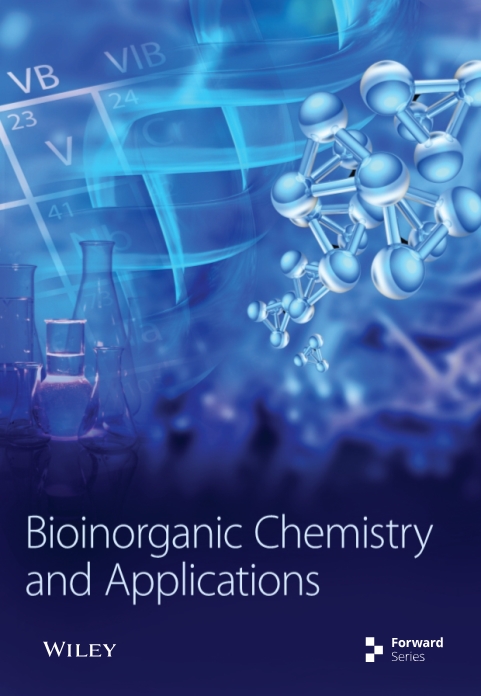Synthesis, Structure, and Biologic Activity of Some Copper, Nickel, Cobalt, and Zinc Complexes with 2-Formylpyridine N4-Allylthiosemicarbazone
IF 4.7
3区 化学
Q1 BIOCHEMISTRY & MOLECULAR BIOLOGY
引用次数: 5
Abstract
A series of zinc(II) ([Zn(H2O)(L)Cl] (1)), copper (II) ([Cu(L)Cl] (2), [Cu(L)Br] (3), [Cu2(L)2(CH3COO)2]·4H2O (4)), nickel(II) ([Ni(HL)2]Cl2·H2O (5)), and cobalt(III) ([Co(L)2]Cl (6)) complexes were obtained with 2-formylpyridine N4-allylthiosemicarbazone (HL). In addition another two thiosemicarbazones (3-formylpyridine N4-allylthiosemicarbazone (HLa) and 4-formylpyridine N4-allylthiosemicarbazone (HLb)) have been obtained. The synthesized thiosemicarbazones have been studied using 1H and 13C NMR spectroscopy, IR spectroscopy, and X-ray diffraction analysis. The composition and structure of complexes were studied using elemental analysis, IR and UV-Vis spectroscopies, molar conductivity, and magnetic susceptibility measurements. Single crystal X-ray diffraction analysis elucidated the structure of thiosemicarbazones HL, HLa, and HLb, as well as complexes 4 and 5. The antiproliferative properties of these compounds toward a series of cancer cell lines (HL-60, HeLa, BxPC-3, RD) and a normal cell line (MDCK) have been investigated. The nickel complex shows high selectivity (SI > 1000) toward HL-60 cell line and is the least toxic. The zinc complex shows the highest selectivity toward RD cell line (SI = 640). The copper complexes (2–4) are the most active molecular inhibitors of proliferation of cancer cells, but exhibit not such a high selectivity and are significantly more toxic. Zinc and copper complexes manifest high antibacterial activity. It was found that calculated at B3LYP level of theory different reactivity descriptors of studied compounds strongly correlate with their biological activity.2-甲酰基吡啶n -烯丙基硫代氨基脲配合物的合成、结构和生物活性
用2-甲酰基吡啶n4 -烯基硫代氨基脲(HL)制备了一系列锌(II) ([Zn(H2O)(L)Cl](1))、铜(II) ([Cu(L)Cl](2)、[Cu(L)Br](3)、[Cu2(L)2(CH3COO)2]·4H2O(4))、镍(II) ([Ni(HL)2]Cl2·H2O(5))和钴(III) ([Co(L)2]Cl(6))配合物。此外,还得到了2个硫代氨基脲(3-甲酰基吡啶n4 -烯基硫代氨基脲(HLa)和4-甲酰基吡啶n4 -烯基硫代氨基氨基脲(HLb))。对合成的硫代氨基脲进行了1H、13C NMR、IR、x射线衍射分析。采用元素分析、红外光谱和紫外可见光谱、摩尔电导率和磁化率等方法研究了配合物的组成和结构。单晶x射线衍射分析证实了硫代氨基脲HL、HLa和HLb以及配合物4和5的结构。研究了这些化合物对一系列癌细胞系(HL-60、HeLa、BxPC-3、RD)和正常细胞系(MDCK)的抗增殖作用。镍配合物对HL-60细胞系具有高选择性(SI > 1000),毒性最小。锌配合物对RD细胞株的选择性最高(SI = 640)。铜配合物(2-4)是最活跃的癌细胞增殖分子抑制剂,但表现出不高的选择性和明显更大的毒性。锌和铜配合物具有较高的抗菌活性。在理论B3LYP水平上计算发现,所研究化合物的不同反应性描述符与其生物活性密切相关。
本文章由计算机程序翻译,如有差异,请以英文原文为准。
求助全文
约1分钟内获得全文
求助全文
来源期刊

Bioinorganic Chemistry and Applications
化学-生化与分子生物学
CiteScore
7.00
自引率
5.30%
发文量
105
审稿时长
>12 weeks
期刊介绍:
Bioinorganic Chemistry and Applications is primarily devoted to original research papers, but also publishes review articles, editorials, and letter to the editor in the general field of bioinorganic chemistry and its applications. Its scope includes all aspects of bioinorganic chemistry, including bioorganometallic chemistry and applied bioinorganic chemistry. The journal welcomes papers relating to metalloenzymes and model compounds, metal-based drugs, biomaterials, biocatalysis and bioelectronics, metals in biology and medicine, metals toxicology and metals in the environment, metal interactions with biomolecules and spectroscopic applications.
 求助内容:
求助内容: 应助结果提醒方式:
应助结果提醒方式:


